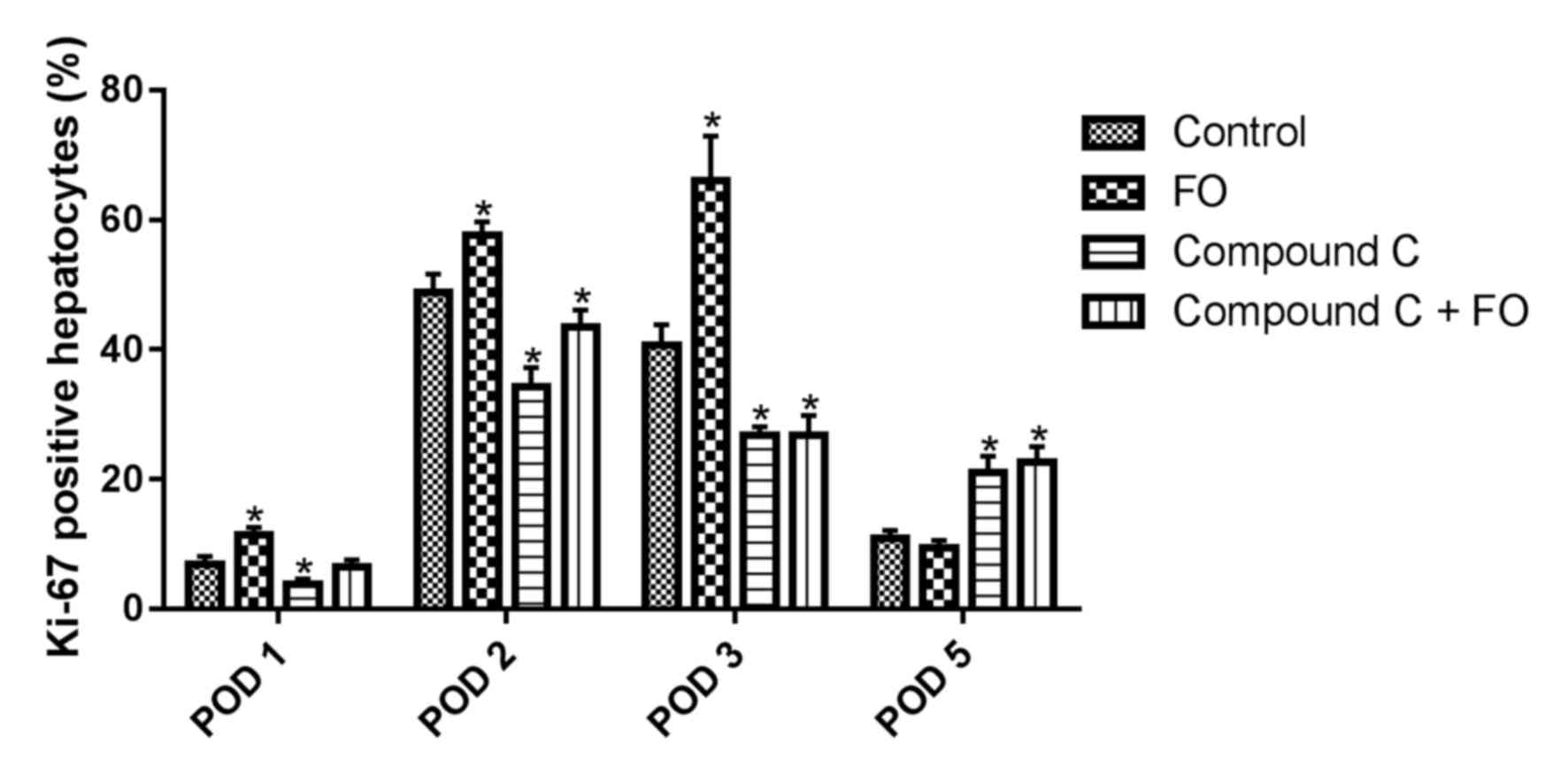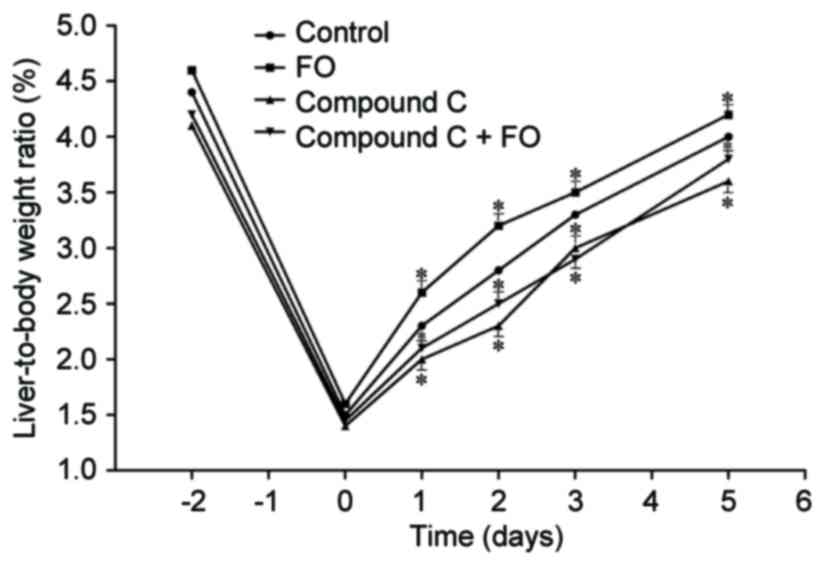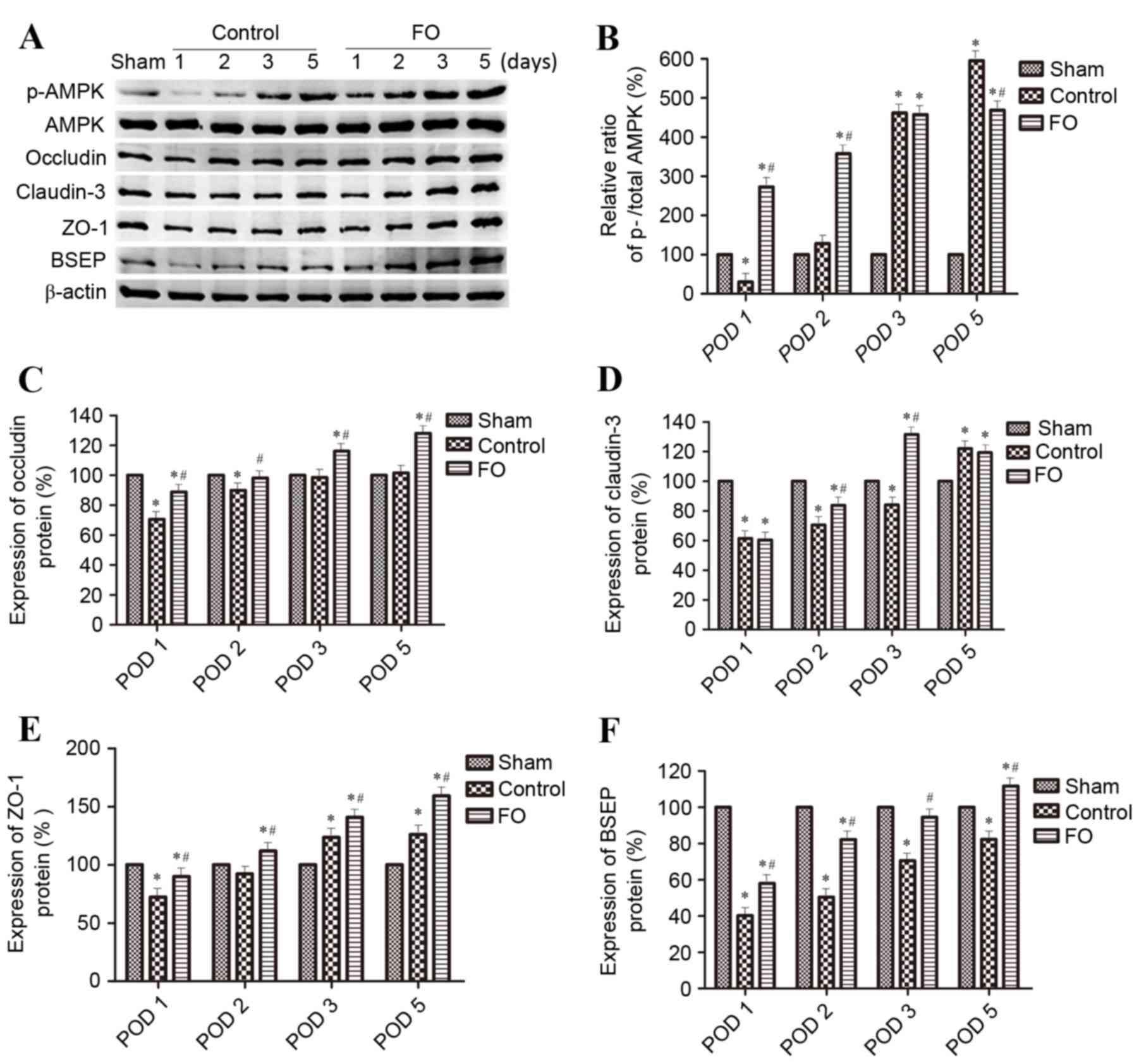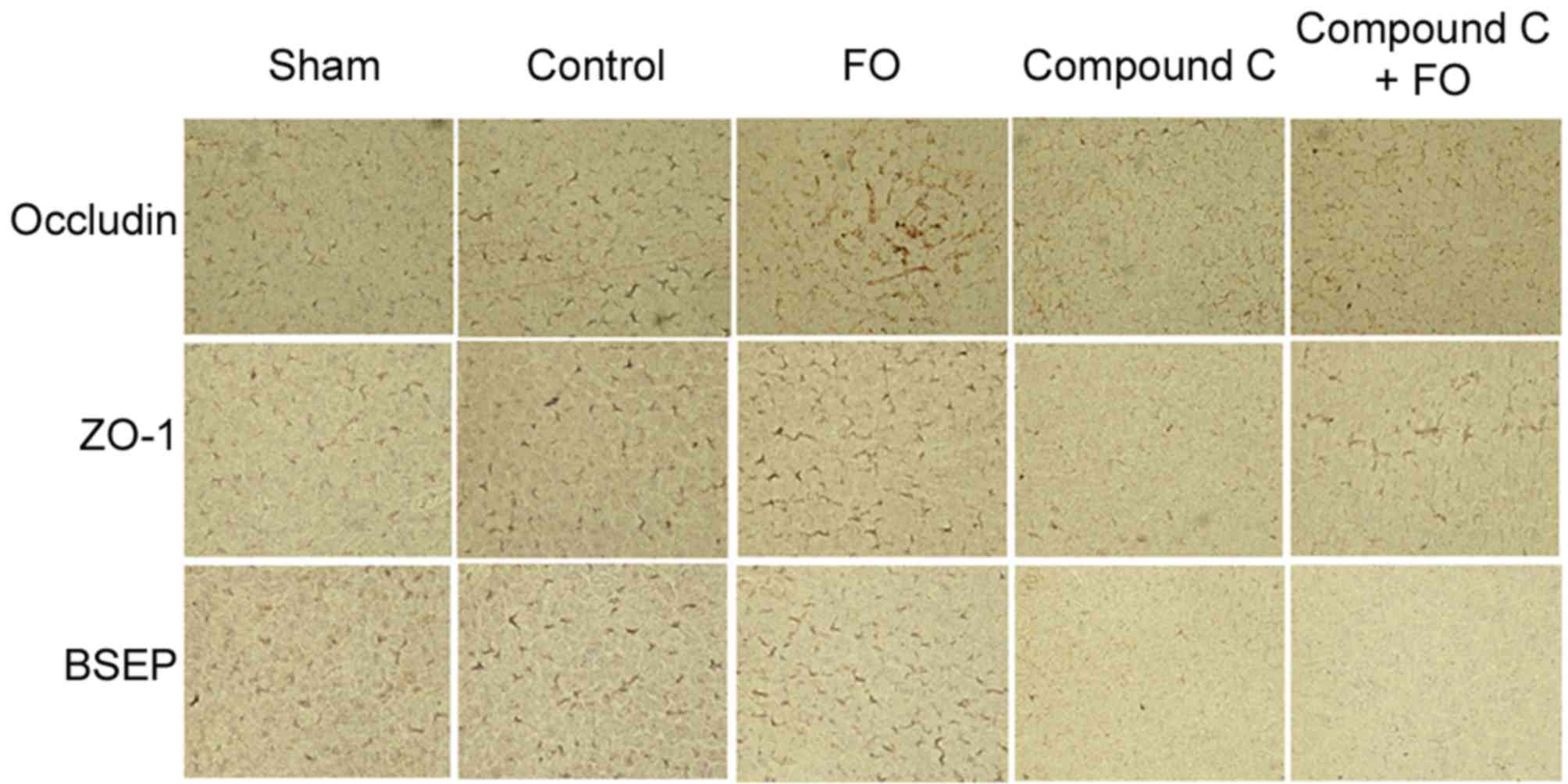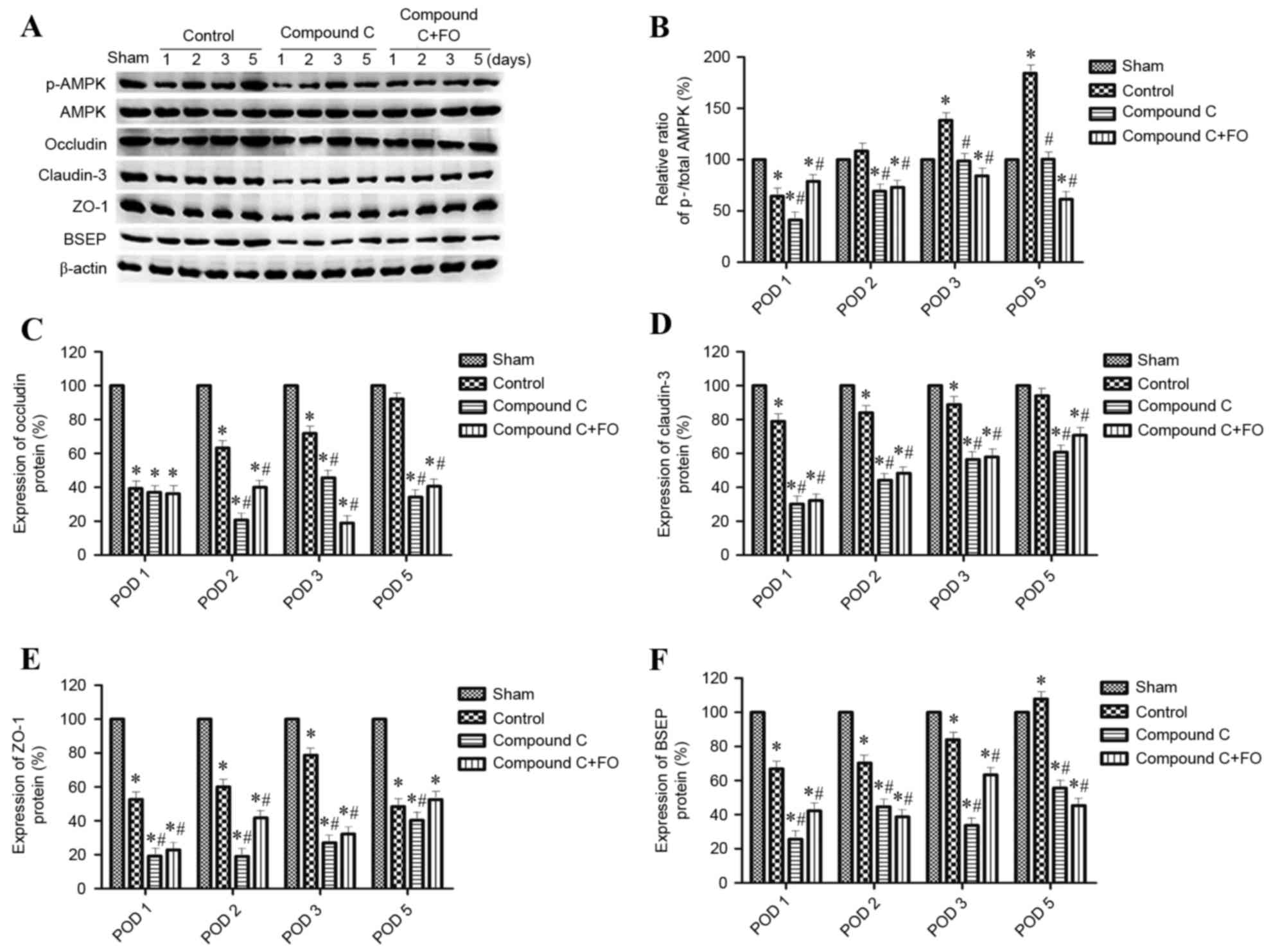Perioperative oral supplementation with fish oil promotes liver regeneration following partial hepatectomy in mice via AMPK activation
- Authors:
- Published online on: December 27, 2017 https://doi.org/10.3892/mmr.2017.8362
- Pages: 3905-3911
Abstract
Introduction
The human liver exerts vital functions, including absorbing metabolites from the intestine, regulating glucose and lipid metabolism and biotransforming xenobiotics. The liver is one of the few organs that can regenerate itself following partial ablation or liver damage. Although hepatocytes have extensive regenerative capacity, there are many diseases in which this capacity is insufficient to compensate for the loss of hepatocytes and liver function (1–3). Over the past three decades, liver regeneration has been studied extensively and several regulatory pathways have been identified, which provided regenerative alternatives to the liver and ensured the return of its mass and function to the size needed for the body (4–7). Previous studies involving humans and rodents have demonstrated that fish oil (FO), which is rich in omega-3 polyunsaturated fatty acids (n-3 PUFAs), ameliorates the degree of liver injury and improves liver function (8,9). However, the mechanism by which dietary supplementation of FO improves liver function remains elusive.
Liver regeneration involves increased cell proliferation and successful hepatocyte polarization. As the main epithelial cells in the liver, hepatocyte polarization, including tight junctional, cytoskeletal and intracellular trafficking components, is essential for the regenerative liver function. The tight junction, a polarized structure, forms a seal between cells, separating the basolateral and apical membrane domains when epithelial cells acquire polarity (10). Bile salt export pump (BSEP) is a member of the ABC superfamily of efflux transporter proteins, and is crucial in the efflux of bile salts (11). Inhibition of BSEP may lead to accumulation of cytotoxic bile salts and eventually have severe consequences such as intrahepatic cholestasis (12).
AMP-activated protein kinase (AMPK), which is a cellular metabolic sensor, has been demonstrated to be involved in liver regeneration (13,14). Generally, AMPK activation switches off ATP-consuming processes and switches on ATP-generating pathways. Following partial hepatectomy (PH), hepatocyte proliferation is associated with increased AMPK phosphorylation. Deletion of AMPK delays liver proliferation by affecting the G1/S transition phase (14). An additional function of AMPK activation is also evident on hepatocyte polarization (15). In collagen sandwich cultures of rat hepatocytes, AMPK regulated bile canalicular network formation and maintenance (13). AMPK activation and canalicular network formation are associated with BSEP trafficking (15).
Based on these previous studies, a hypothesis was formed that oral supplementation with FO may be able to induce AMPK activation and regulate hepatocyte polarization markers, thereby promoting the recovery of liver function during PH.
Materials and methods
Animal experiments
A total of 120 ICR mice (n=24/group, n=6/time interval; male; 25–30 g; 8–15 weeks old) obtained from the Animal Experimental Center, Nanjing Drum Tower Hospital, Medical School of Nanjing University (Nanjing, China) were used for simple 70% PH experiments. Mice were housed under conditions of 60% humidity, a temperature of 18–22°C, a 12 h light/dark cycle and free access to food and water. Mice were fasted overnight prior to PH. Anesthesia was induced with chloral hydrate (10%; 350 mg/kg) by intraperitoneal (i.p.) injection. Following laparotomy, the median and left liver lobes were surgically removed resulting in 70% PH. Mice were sacrificed via carbon dioxide inhalation asphyxia to collect blood and liver specimens prior to PH (days −2 and 0) and following PH (days 1, 2, 3 and 5), and the recovery of liver mass was estimated by the liver-to-body weight ratios. The experimental design was examined and approved by the Experimental Animal Ethics Committee of the Nanjing Drum Tower Hospital, Medical School of Nanjing University (Nanjing, China).
Experimental groups
All animals were divided randomly into 5 groups (n=24 per group): i) Sham; ii) Control; iii) Compound C (Selleck Chemicals, Houston, TX, USA), which is the AMPK inhibitor dorsomorphin; iv) FO [comprising 40% docosahexaenoic acid (DHA) and 40% eicosapentaenoic acid (EPA); Wuhan Shengtianyu Biotechnology, Wuhan, China]; and v) Compound C + FO. Mice in the Sham group had laparotomy and exposure of the liver, but no PH. Mice in the Control group had 70% PH without any treatment. Mice in the Compound C group had 70% PH and treatment with Compound C (8 mg/kg) by i.p. injection daily, beginning half an hour prior to the operation until the day prior to the indicated time. Mice in the FO group had 70% PH and treatment with FO (12 ml/kg) by oral gavage daily, beginning at 2 days prior to the operation until the day prior to the indicated time. Mice in the Compound C + FO group had 70% PH and treatment with FO (12 ml/kg) by oral gavage daily from 2 days prior the operation until the day prior to the indicated time and Compound C (8 mg/kg) by i.p. injection daily from half an hour prior to the operation until the day prior to the indicated time.
Western blotting
A total of 50 mg liver tissues were lysed in cold radioimmunoprecipitation assay buffer (Beyotime Institute of Biotechnology, Haimen, China) containing 1:100 volume of phenylmethylsulfonyl fluoride. Following lysis at 4°C for 1 h, cell lysates were centrifuged at 14,000 × g for 5 min at 4°C. The total protein concentration in the supernatant was determined by Bicinchoninic Acid assay (Beyotime Institute of Biotechnology). Proteins were separated by 10% SDS-PAGE (30 µg/lane) and transferred to a nitrocellulose membrane at 100 V for 60 min. Following blocking in TBS + 0.1% Tween-20 (TBST) buffer containing 5% bovine serum albumin (BSA; Absin Bioscience Inc., Shanghai, China) at 37°C for 1 h, the membranes were incubated in TBST containing 2% BSA and antibodies against Occludin (cat. no. ab64482; 1:1,000; Abcam, Cambridge, UK), Claudin-3 (cat. no. sc-17662; 1:1,000; Santa Cruz Biotechnology, Inc., Dallas, TX, USA), tight junction protein ZO-1 (ZO-1; cat. no. sc-10804; 1:1,000; Santa Cruz Biotechnology, Inc.), phosphorylated (p)-AMPK (cat. no. sc-33524; 1:1,000; Santa Cruz Biotechnology, Inc.), AMPK (cat. no. sc-33524; 1:1,000; Santa Cruz Biotechnology, Inc.) and BSEP (cat. no. sc-74500; 1:1,000; Santa Cruz Biotechnology, Inc.) at 37°C for 1 h. An antibody against β-actin (cat. no. 4970; 1:5,000; Cell Signaling Technology, Inc., Danvers, MA, USA) was used as an internal control. The membranes were washed three times with TBST and incubated with the following secondary antibodies at 37°C for 1 h: Goat anti-rabbit horseradish peroxidase (HRP)-conjugated antibody (cat. no. BA1055; 1:5,000; Boster Biological Technology, Pleasanton, CA, USA), HRP-goat anti-mouse antibody (cat. no. BA1051; 1:5,000; Boster Biological Technology) and HRP-rabbit anti-goat antibody (cat. no. BA1060; 1:5,000; Boster Biological Technology). Following three washes with TBST, the target proteins were detected using an Enhanced Chemiluminescence kit (WBULS0500; EMD Millipore, Billerica, MA, USA). Densitometry analysis was performed using the Intel iPP 6.0 software (Intel Corporation, Santa Clara, CA, USA).
Immunohistochemical assays
Paraffin-embedded liver tissue sections (~4 µm) were fixed in 4% paraformaldehyde at room temperature for 24 h, deparaffinized and dehydrated through graded ethanol. The sections were washed 3 times with PBS for 5 min each, and then treated with 3% hydrogen peroxide for 10 min at room temperature to block the endogenous peroxidase activity. The sections were subsequently washed 3 times with PBS for 5 min each. Following blocking with 5% BSA for 30 min at 37°C, sections were incubated with primary antibodies against Occludin, ZO-1, BESP or Ki-67 (1:200 dilution in PBS) overnight and then with a HRP-conjugated anti-rabbit immunoglobulin G secondary antibody (cat. no. BA1055; 1:100; Boster Biological Technology) for 1 h at room temperature. Finally, the sections were incubated with 3,3-diaminobenzidine reagent for 10 min, counterstained with hematoxylin, dehydrated and mounted for inverted phase contrast microscopy (CK30 OLYMPUS; Olympus Corporation, Tokyo, Japan) analysis.
Serum biochemical parameters
Serum expression levels of alanine aminotransferase (ALT), aspartate aminotransferase (AST), total bilirubin (TBIL), albumin (ALB) and C-reactive protein (CRP) were determined by the Laboratory of Biochemistry, Nanjing Drum Tower Hospital, Medical School of Nanjing University (Nanjing, China).
Statistical analysis
GraphPad Prism software version 5.01 (GraphPad Software, Inc., La Jolla, CA, USA) and PASW statistics version 18.0 (SPSS, Inc., Chicago, IL, USA) were used for statistical analyses. Results are expressed as the mean ± standard deviation. One-way analysis of variance followed by the Least Significant Difference post hoc test was used to detect the statistically significant variations between groups. Each experiment was performed in triplicate. P<0.05 was considered to indicate a statistically significant difference.
Results
Perioperative oral supplementation with FO improves liver function through AMPK activation following PH
Serum levels of ALT, AST, TBIL, ALB and CRP were evaluated at 1, 2, 3 and 5 days following PH to evaluate postoperative hepatic function (Table I). Following PH, the serum levels of ALT and AST in the Control mice were significantly increased compared with Sham (P<0.05; Table I), followed by a gradual trend to be restored to normal over time. When PH was accompanied by perioperative FO supplementation, the restoration of serum ALT and TBIL levels was significantly faster than those in the Control group (P<0.05 from day 2 and day 3 post-PH, respectively; Table I). To further examine the mechanism involved in the effects of perioperative FO supplementation on liver function, AMPK was inhibited by i.p. injection of Compound C. The levels of ALT and AST were significantly higher in the Compound C group compared with the Control group on day 2 post-PH, with or without perioperative FO supplementation (P<0.05; Table I). These results indicated that liver function improvement following PH in mice with perioperative oral FO supplementation may be mediated through AMPK signaling.
To investigate the mechanisms of FO supplementation on improving liver function through AMPK activation, hepatocyte proliferation was examined following PH by immunohistochemical staining for the Ki-67 proliferation marker. The proportion of Ki-67 positive hepatocytes in the livers of the FO group was significantly increased compared with the Control group on days 1, 2 and 3 following PH (P<0.05; Fig. 1). On day 5 following PH, there was no difference between the FO group and the Control group (P>0.05; Fig. 1). Measurement of the liver-to-body weight ratio reflected the results of hepatocyte proliferation. Perioperative oral supplementation with FO significantly increased postoperative liver-to-body weight ratio in mice undergoing PH compared with Control (P<0.05; Fig. 2). To further examine the mechanism involved in the effects of perioperative FO supplementation on hepatocyte proliferation, AMPK was inhibited by use of Compound C by i.p. injection. The proportion of Ki-67 positive hepatocytes was significantly decreased in the livers of the Compound C-treated group compared with the Control group from day 1 to 3 following PH, which was not resolved by perioperative oral supplementation with FO (P<0.05 vs. Control; Fig. 1). The discrepant results of proliferation at day 5 may be explained in that the AMPK inhibitor may have delayed the process of hepatocyte proliferation and FO treatment was unable to reverse it, which was consistent with the liver-to-body weight ratio. The liver-to-body weight ratio was also decreased in the Compound C group compared with the Control group from day 1 to 5 following PH, and treatment with perioperative FO supplementation did not improve it (P<0.05; Fig. 2). These data suggested that perioperative oral supplementation with FO promoted hepatocyte proliferation in mice following PH and this effect was mediated through AMPK signaling.
Perioperative oral supplementation with FO promotes the expression of tight junction and BSEP proteins through AMPK activation following PH
To further investigate the effects of perioperative FO supplementation on liver regeneration following PH, the expression levels hepatocyte polarization markers were examined. Polarization was evaluated by western blot analysis and immunohistochemistry for the expression of epithelial differentiation markers Occludin, Claudin-3 and ZO-1, and the hepatocyte marker BSEP. Phosphorylation levels of AMPK were also evaluated as a marker of AMPK signaling activation. The ratio of p-AMPK/total AMPK and the protein expression levels of Occludin, Claudin-3, ZO-1 and BSEP were gradually increased between day 1 and day 5 following PH in the Control group (Figs. 3 and 4). Perioperative oral supplementation with FO further enhanced this change (Figs. 3 and 4). To evaluate the effects of AMPK signaling on tight junction and BSEP protein expression, AMPK was inhibited by i.p. injection with Compound C (Fig. 5). The level of p-AMPK expression was reduced in the Compound C group compared with the Control group (P<0.05; Fig. 5A and B), as was expression of Occludin, Claudin-3, ZO-1 and BSEP; however, the level of p-AMPK expression was still reduced in the Compound C+FO group compared with the Control group between days 2 and 5 (P<0.05; Fig. 5). In conclusion, the results demonstrated that perioperative FO oral supplementation promoted the expression of hepatocyte polarization markers in mice following PH and this effect was probably mediated through AMPK activation.
Discussion
Results from the present study demonstrated that oral supplementation with FO facilitated hepatocyte proliferation and the expression of hepatocyte polarization markers through AMPK activation, thereby improving liver function following PH. Serum levels of liver enzymes ALT and AST, as well as TBIL, were significantly decreased by perioperative FO oral supplementation, indicating an improvement in liver function. As hepatocyte polarization is essential for liver function, the hypothesis that FO might promote polarization of liver parenchyma to improve liver function was further tested. In addition, the role of AMPK activation in the FO-mediated effect of decreasing liver injury and improving liver function was examined. The present study revealed that AMPK activation was essential for hepatocyte proliferation and hepatocyte polarization marker expression following PH. AMPK inhibition not only suppressed cell proliferation, but also delayed cell polarization in the liver.
FO is rich in n-3 PUFA and has been demonstrated to reduce liver enzyme expression levels and to improve liver function in patients undergoing surgery (16). A meta-analysis performed by Pradelli et al demonstrated that parenteral supplementation with FO significantly reduced liver enzymes and improved liver viability in both intensive care unit (ICU) and non-ICU patients (9). Studies in humans and rodents revealed that n-3 PUFA ameliorated the degree of liver injury (8,17). Previous studies from our group have also demonstrated that n-3 PUFA protected postoperative hepatic function following 70% PH and prevented acute liver failure following 90% hepatectomy in rats (18,19). Therefore, dietary supplementation with FO has the potential to reduce liver injury and improve liver function, which is consistent with the findings of the present study. However, the exact mechanism for this function of FO remained unclear.
The present study also demonstrated that liver function, along with expression of hepatocyte polarization markers, gradually recovered following PH. Induction of hepatocyte polarization may reduce liver injury and improve liver viability, and inhibition of hepatocyte polarization markers may delay the recovery of liver function. Hepatocytes are the main epithelial cells in the liver and they are regularly polarized (20). Hepatocyte polarization involves formation of functionally distinct sinusoidal (basolateral) and bile canalicular (apical) plasma membrane domains that are separated by tight junction proteins, including Occludin, Claudin and ZO-1 (21). BSEP is mainly localized to the canalicular membrane of hepatocytes and serves a crucial role in the disposition of conjugated bile salts from the liver to the bile canaliculi (11). The inhibition of BSEP may lead to the accumulation of cytotoxic bile salts and, eventually, to severe consequences such as intrahepatic cholestasis. Cholestatic hepatocytes cause deteriorated barrier function of tight junctions (22). Therefore, hepatocyte polarization is essential for biliary secretion. Loss of polarity leads to cholestasis and liver damage (10).
In the present study, FO-mediated AMPK activation induced the expression of tight junction and BSEP proteins. AMPK is a sensor of cellular energy homeostasis that is important in energy regulation and metabolism (13). Previous studies have demonstrated that AMPK serves a role downstream of liver kinase B1 (LKB1) to confer cell polarity (23–25). In metazoan species, AMPK functions not only in controlling metabolism, but also in regulating cell structures (23). Activated LKB1 induces three major aspects of intestinal epithelial polarity in a cell-autonomous way, including forming an apical brush border, positioning junctional proteins around this brush border, and correctly sorting the basolateral and apical plasma membrane markers (24). In the polarized renal epithelial cells, AMPK also regulates tight junction assembly. Activation of AMPK facilitates tight junction assembly, whereas expression of a dominant negative AMPK construct inhibits it (25). A previous study demonstrated that hepatocyte polarization, manifested by canalicular network formation, is sequential and is associated with activation of AMPK and LKB1 in collagen sandwich cultures of rat hepatocytes (13). The canalicular network formation was accelerated by activation of AMPK and LKB1 and was blocked by inhibition of AMPK or LKB1 (13). Another previous study demonstrated that LKB1 regulates BSEP trafficking to the bile canalicular membrane, canalicular network formation and hepatocyte polarization (15).
The present study revealed that oral supplementation with FO facilitated hepatocyte polarization by AMPK activation, thereby improving liver function following PH. However, the mechanism by which FO increases AMPK phosphorylation is not understood. Previous studies have demonstrated that AMP initiates the activation of AMPK by LKB1 (26,27). In addition, it has been reported that cAMP accelerates hepatocyte polarization via the LKB1/AMPK pathway (10,15). Further studies will be required to address which of these factors are induced by FO to regulate hepatocyte polarization. In addition, n-3 PUFA, including EPA and DHA, are enriched in FO. Further investigation will be required to examine in detail the relationship between n-3 PUFA and AMPK activation.
In conclusion, the present study demonstrated that oral supplementation with FO facilitated liver regeneration by AMPK activation, thereby improving liver function following PH.
Acknowledgements
The authors acknowledge the financial support from the National Natural Science Fund of China (grant no. 81470866).
Glossary
Abbreviations
Abbreviations:
|
FO |
fish oil |
|
n-3 PUFA |
omega-3 polyunsaturated fatty acid |
|
BSEP |
bile salt export pump |
|
AMPK |
AMP-activated protein kinase |
|
PH |
partial hepatectomy |
|
ALT |
alanine aminotransferase |
|
AST |
aspartate aminotransferase |
|
TBIL |
total bilirubin |
|
ALB |
albumin |
|
CRP |
C-reactive protein |
References
|
Ding BS, Cao Z, Lis R, Nolan DJ, Guo P, Simons M, Penfold ME, Shido K, Rabbany SY and Rafii S: Divergent angiocrine signals from vascular niche balance liver regeneration and fibrosis. Nature. 505:97–102. 2014. View Article : Google Scholar : PubMed/NCBI | |
|
Willenbring H and Grompe M: A therapy for liver failure found in the JNK yard. Cell. 153:283–284. 2013. View Article : Google Scholar : PubMed/NCBI | |
|
Fausto N, Campbell JS and Riehle KJ: Liver regeneration. Hepatology. 43 2 Suppl 1:S45–S53. 2006. View Article : Google Scholar : PubMed/NCBI | |
|
Wuestefeld T, Pesic M, Rudalska R, Dauch D, Longerich T, Kang TW, Yevsa T, Heinzmann F, Hoenicke L, Hohmeyer A, et al: A direct in vivo RNAi screen identifies MKK4 as a key regulator of liver regeneration. Cell. 153:389–401. 2013. View Article : Google Scholar : PubMed/NCBI | |
|
Taub R: Liver regeneration: From myth to mechanism. Nat Rev Mol Cell Biol. 5:836–847. 2004. View Article : Google Scholar : PubMed/NCBI | |
|
Michalopoulos GK: Principles of liver regeneration and growth homeostasis. Compr Physiol. 3:485–513. 2013.PubMed/NCBI | |
|
He VJ: Professor Norbert Hüser: The function of immune cells for liver regeneration after partial hepatectomy. Hepatobiliary Surg Nutr. 3:52–54. 2014.PubMed/NCBI | |
|
Svegliati-Baroni G, Candelaresi C, Saccomanno S, Ferretti G, Bachetti T, Marzioni M, De Minicis S, Nobili L, Salzano R, Omenetti A, et al: A model of insulin resistance and nonalcoholic steatohepatitis in rats: Role of peroxisome proliferator-activated receptor-alpha and n-3 polyunsaturated fatty acid treatment on liver injury. Am J Pathol. 169:846–860. 2006. View Article : Google Scholar : PubMed/NCBI | |
|
Pradelli L, Mayer K, Muscaritoli M and Heller AR: n-3 fatty acid-enriched parenteral nutrition regimens in elective surgical and ICU patients: A meta-analysis. Crit Care. 16:R1842012. View Article : Google Scholar : PubMed/NCBI | |
|
Fu D, Wakabayashi Y, Lippincott-Schwartz J and Arias IM: Bile acid stimulates hepatocyte polarization through a cAMP-Epac-MEK-LKB1-AMPK pathway. Proc Natl Acad Sci USA. 108:pp. 1403–1408. 2011; View Article : Google Scholar : PubMed/NCBI | |
|
International Transporter Consortium, ; Giacomini KM, Huang SM, Tweedie DJ, Benet LZ, Brouwer KL, Chu X, Dahlin A, Evers R, Fischer V, et al: Membrane transporters in drug development. Nat Rev Drug Discov. 9:215–236. 2010. View Article : Google Scholar : PubMed/NCBI | |
|
Woods A, Heslegrave AJ, Muckett PJ, Levene AP, Clements M, Mobberley M, Ryder TA, Abu-Hayyeh S, Williamson C, Goldin RD, et al: LKB1 is required for hepatic bile acid transport and canalicular membrane integrity in mice. Biochem J. 434:49–60. 2011. View Article : Google Scholar : PubMed/NCBI | |
|
Fu D, Wakabayashi Y, Ido Y, Lippincott-Schwartz J and Arias IM: Regulation of bile canalicular network formation and maintenance by AMP-activated protein kinase and LKB1. J Cell Sci. 123:3294–3302. 2010. View Article : Google Scholar : PubMed/NCBI | |
|
Merlen G, Gentric G, Celton-Morizur S, Foretz M, Guidotti JE, Fauveau V, Leclerc J, Viollet B and Desdouets C: AMPKα1 controls hepatocyte proliferation independently of energy balance by regulating Cyclin A2 expression. J Hepatol. 60:152–159. 2014. View Article : Google Scholar : PubMed/NCBI | |
|
Homolya L, Fu D, Sengupta P, Jarnik M, Gillet JP, Vitale-Cross L, Gutkind JS, Lippincott-Schwartz J and Arias IM: LKB1/AMPK and PKA control ABCB11 trafficking and polarization in hepatocytes. PLoS One. 9:e919212014. View Article : Google Scholar : PubMed/NCBI | |
|
Stehr SN and Heller AR: Omega-3 fatty acid effects on biochemical indices following cancer surgery. Clin Chim Acta. 373:1–8. 2006. View Article : Google Scholar : PubMed/NCBI | |
|
Zhu XH, Wu YF, Qiu YD, Jiang CP and Ding YT: Liver-protecting effects of omega-3 fish oil lipid emulsion in liver transplantation. World J Gastroenterol. 18:6141–6147. 2012. View Article : Google Scholar : PubMed/NCBI | |
|
Yan XP, Wang S, Yang Y and Qiu YD: Effects of n-3 polyunsaturated fatty acids on rat livers after partial hepatectomy via LKB1-AMPK signaling pathway. Transplant Proc. 43:pp. 3604–3612. 2011; View Article : Google Scholar : PubMed/NCBI | |
|
Qiu YD, Wang S, Yang Y and Yan XP: Omega-3 polyunsaturated fatty acids promote liver regeneration after 90% hepatectomy in rats. World J Gastroenterol. 18:3288–3295. 2012.PubMed/NCBI | |
|
Grosse B, Degrouard J, Jaillard D and Cassio D: Build them up and break them down: Tight junctions of cell lines expressing typical hepatocyte polarity with a varied repertoire of claudins. Tissue Barriers. 1:e252102013. View Article : Google Scholar : PubMed/NCBI | |
|
Son S, Kojima T, Decaens C, Yamaguchi H, Ito T, Imamura M, Murata M, Tanaka S, Chiba H, Hirate K and Sawada N: Knockdown of tight junction protein claudin-2 prevents bile canalicular formation in WIF-B9 cells. Histochem Cell Biol. 131:411–424. 2009. View Article : Google Scholar : PubMed/NCBI | |
|
Kojima T, Yamamoto T, Murata M, Chiba H, Kokai Y and Sawada N: Regulation of the blood-biliary barrier: Interaction between gap and tight junctions in hepatocytes. Med Electron Microsc. 36:157–164. 2003. View Article : Google Scholar : PubMed/NCBI | |
|
Lee JH, Koh H, Kim M, Kim Y, Lee SY, Karess RE, Lee SH, Shong M, Kim JM, Kim J and Chung J: Energy-dependent regulation of cell structure by AMP-activated protein kinase. Nature. 447:1017–1020. 2007. View Article : Google Scholar : PubMed/NCBI | |
|
Baas AF, Kuipers J, van der Wel NN, Batlle E, Koerten HK, Peters PJ and Clevers HC: Complete polarization of single intestinal epithelial cells upon activation of LKB1 by STRAD. Cell. 116:457–466. 2004. View Article : Google Scholar : PubMed/NCBI | |
|
Zhang L, Li J, Young LH and Caplan MJ: AMP-activated protein kinase regulates the assembly of epithelial tight junctions. Proc Natl Acad Sci USA. 103:pp. 17272–17277. 2006; View Article : Google Scholar : PubMed/NCBI | |
|
Zhang YL, Guo H, Zhang CS, Lin SY, Yin Z, Peng Y, Luo H, Shi Y, Lian G, Zhang C, et al: AMP as a low-energy charge signal autonomously initiates assembly of AXIN-AMPK-LKB1 complex for AMPK activation. Cell Metab. 18:546–555. 2013. View Article : Google Scholar : PubMed/NCBI | |
|
Gowans GJ, Hawley SA, Ross FA and Hardie DG: AMP is a true physiological regulator of AMP-activated protein kinase by both allosteric activation and enhancing net phosphorylation. Cell Metab. 18:556–566. 2013. View Article : Google Scholar : PubMed/NCBI |



